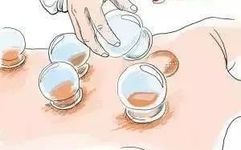1. Understanding the True—Cupping Therapy in Traditional Chinese Medicine:

As a part of Traditional Chinese Medicine (TCM), its application should be strictly based on TCM theories after a detailed examination of the patient’s condition. The true “cupping method” is not the flashy version seen in neon-lit streets. This article is intended as a warning.
Cupping therapy, also known as “fire cupping” or “qi cupping,” was historically referred to as “horn method.” It utilizes a cup as a tool, employing the heat from burning to expel air from the cup, allowing it to adhere to the skin, creating a warming stimulus and causing a phenomenon of blood stasis.
The Han Dynasty tomb of Mawangdui in Changsha records in the silk book “Fifty-Two Disease Formulas”: “Mu Zhi (Mugwort) is located beside the orifice… using a small horn to treat it.”
In the Jin Dynasty, Ge Hong’s “Emergency Prescriptions for Emergencies” states: “Cups made from cow horns are used for surgical purposes to draw out pus and blood, hence the name ‘horn method’ and ‘suction tube therapy.'”
In the Qing Dynasty, Zhao Xue Min’s “Compendium of Materia Medica Supplement” mentions “fire cupping” saying: “When the cup obtains the heat and adheres to the flesh, it cannot be removed easily; it must fall off on its own. The patient feels a warm sensation entering through the pores, and after a while, when the fire’s energy is exhausted, it falls off, leaving a red flush on the skin, and moisture escapes from the cup, expelling wind and cold.”
Later generations of physicians continuously expanded the treatment scope, making cupping therapy applicable to various clinical diseases, becoming an important component of TCM.
The Functions of Cupping Therapy
Cupping therapy acts on the skin’s “luo vessels”. As stated in the “Su Wen: Discussion on the Skin”: “Therefore, the onset of all diseases begins with the skin and hair,” and again, “The skin is the part of the vessels. If evil invades the skin, the pores open, allowing the evil to enter the luo vessels; when the luo vessels are full, they inject into the meridians; when the meridians are full, they enter the organs.”
This indicates that external evils invade the body through the skin, floating luo, luo vessels, and meridians, causing disease. Therefore, cupping therapy can exert therapeutic effects through beneficial stimulation of local luo vessels, meridians, and acupoints.
Cupping therapy has a wide range of applications. Due to its large area of effect, including acupoints and luo vessels, it can be applied in various clinical departments.
When used correctly, the main functions of cupping therapy can include: warming the meridians and unblocking the luo vessels, dispelling wind and cold, eliminating dampness, promoting qi and blood circulation, reducing swelling and alleviating pain, clearing heat and draining fire, supporting the righteous and expelling evil, adjusting the organs, and balancing yin and yang.
Common Methods of Cupping Therapy
The “Su Wen: Discussion on Regulating Menstruation” states: “All diseases arise from either deficiency or excess.” Therefore, cupping therapy should also follow the principle of “drain if excessive, tonify if deficient.”
Clinically, based on the condition or the site of the disease, different sizes of transparent glass cups are selected, using the flash fire method to distinguish between deficiency and excess, applying tonification or draining methods. Common methods include:
1. Retaining Cups
Also known as sitting cupping. After cupping, the cup is left in place for a certain period, during which the skin may show redness and blood stasis; the usual retention time is 5 to 15 minutes; for thinner skin, the retention time should not be too long.
This method is the most commonly used and is suitable for various diseases and difficult conditions.
For deficiency conditions: use appropriate small or medium cups, or large cups with a gentle suction force, retaining for a shorter time, as a tonification method.
For excess conditions: use large cups, applying multiple cups closely, with a strong suction force, retaining for a longer time to achieve a certain level of stimulation, as a draining method.
2. Sliding Cups
Also known as push cupping.
Select appropriate glass cups with a thicker, smoother rim, applying a layer of lubricating oil at the rim or suction area, or using herbal liquid or safflower oil based on the condition. After suctioning the cup to the skin, hold the bottom of the cup and repeatedly push it up and down or side to side until the skin turns red.
This method is generally used on larger areas with thick muscles, such as the lower back and thighs; for the chest, smaller cups can be used in the direction of the ribs.
For deficiency conditions: slide with the meridian flow, using low heat and light suction for minimal stimulation, until the skin shows redness, as a tonification method.
For excess conditions: slide against the meridian flow, using high heat and strong suction for greater stimulation, until the skin shows purple-red or cupping marks, as a draining method.
This method combines the effects of cupping with the additional benefits of scraping, enhancing the stimulation of cupping on the body.
It is suitable for conditions of qi and blood stagnation, internal heat toxins, organ diseases, stubborn insomnia, and wind-cold-damp obstruction.
3. Bloodletting Cupping
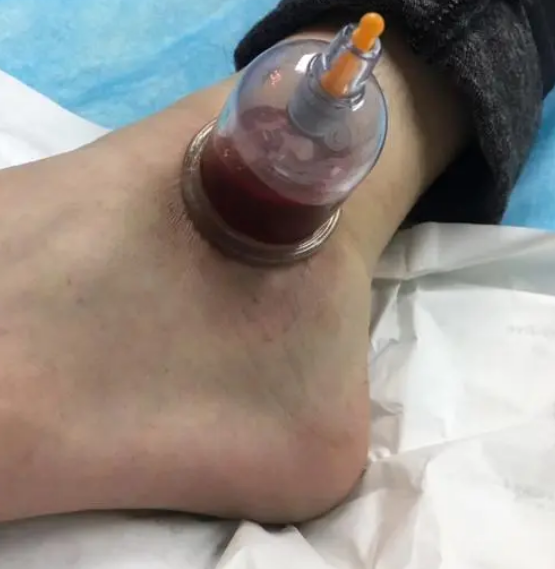
Bloodletting combined with cupping is a commonly used method in clinical practice with a wide range of applications.
First, select the acupoint or area, and use a thick needle or three-edged needle to lightly puncture the skin (luo vessels) to induce bleeding, then apply the cupping to the bleeding site, retaining for 5 to 15 minutes depending on the amount of bleeding.
For deficiency conditions: light puncture (Sun Luo) with the skin appearing red or slightly showing blood points. Use low heat and light suction, allowing slight bleeding in the cup, with the skin turning red, as a tonification method.
For excess conditions: based on the condition, use medium puncture to induce slight bleeding or heavy puncture for point bleeding. Use high heat and strong suction, with each cup containing about 1ml of blood; for severe conditions, the bleeding amount can be more, as a draining method.
Bloodletting cupping can unblock stagnation in the meridians and promote qi and blood flow, clear heat and drain fire, expel evil toxins, adjust organ functions, and treat mixed deficiency and excess conditions, allowing harmful pathogens to be expelled.
4. Flash Cupping
Select an acupoint or area, apply the cup to the skin, and immediately remove it, repeating this process multiple times until the skin turns red or cupping marks appear.
For deficiency conditions: use low heat and light suction, repeating multiple times until the area is slightly or moderately red, as a tonification method.
For excess conditions: use high heat and strong suction, repeating multiple times until the area is purple-red or cupping marks appear, as a draining method.
Flash cupping, through the repeated tightening and loosening of local luo vessels or acupoints, can smooth the meridians, promote qi and blood circulation, adjust deficiency and excess, and balance yin and yang.
It is suitable for wind-cold-damp obstruction, local pain, skin numbness, and functional decline in deficiency conditions, as well as patients who should not retain cups.
5. Needle Cupping
Also known as needle retention cupping, this method involves inserting a needle into a specific acupoint or area to obtain qi, then retaining the needle while applying a cup over the needle point. After a certain retention time, the cup is removed, followed by the needle.
During operation, care should be taken that the needle handle is not too long to avoid touching the bottom of the cup, which could cause the needle to penetrate too deeply. Caution is especially needed for the chest and back areas, as cupping can easily alter the depth of the needle, preventing accidents.
The tonification or draining method can be determined based on the heat level, skin color, and retention time. This method has the dual effects of acupuncture and cupping, suitable for stubborn pain, wind-cold-damp obstruction, etc.
6. Skin Reactions from Cupping Therapy
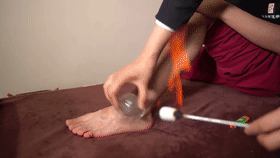
During or after cupping, the skin under the cup may show redness, purple-red, dark purple, or blisters, which are normal pathological reactions and generally subside naturally within 3 to 5 days. The main pathological reactions include:
1. Bright red skin under the cup often indicates an early invasion of wind evil into the luo vessels, or stagnation of external evils in the floating luo of the skin, or manifestations of yin deficiency.
2. Purple-red skin indicates cold evil; dark purple indicates qi stagnation and blood stasis; if dark purple with spots, it indicates fire toxins, excess heat, or cold coagulation and blood stasis.
3. Mild itching of the skin under the cup indicates wind evil; if moisture or beads of water appear in the cup, it indicates excess dampness.
4. Skin under the cup shows no color change or appears pale and cool, indicating deficiency cold.
5. If during retention, the skin shows itching or pain, it may indicate impending blister formation or excess wind-cold-dampness in the body. Close observation of the skin condition under the cup is necessary, and the retention time may need to be shortened.
6. Blisters on the skin under the cup often indicate excess cold-dampness or fire toxins.
Some may develop blisters within 3 to 5 minutes of cupping, indicating internal fire toxins or excess dampness, or overflowing dampness in the luo vessels, or due to weak defensive qi.
Generally, after several rounds of cupping, if the condition improves, blisters may not appear again.
Excessive heat or tight suction can easily cause blisters; prolonged retention time can also lead to blisters; however, in the absence of disease, blisters rarely occur.
Large blisters can be punctured to release fluid, while small blisters can be absorbed naturally, generally not prone to infection.
The fluid in the blisters, if clear and transparent, indicates excess cold-dampness; if yellow, it indicates excess damp-heat; if dark purple, it indicates qi stagnation and blood stasis. The occurrence of blisters from cupping is similar to the effects of direct moxibustion, providing good clinical therapeutic effects.
Due to individual differences in constitution and symptoms, the skin may show different pathological reactions. Therefore, mastering the tonification and draining methods of cupping and the appropriate level of stimulation can enhance clinical efficacy.
2. What Are the Six Major Functions of Cupping Therapy with Bloodletting? Why Do Blisters and Blood Blisters Occur During Cupping?
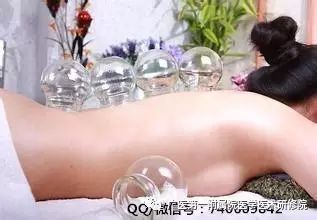
Cupping is a common TCM treatment method often used for bloodletting therapy, which can detoxify. Many people often undergo cupping and bloodletting treatment when they have a cold, but few truly understand the benefits of cupping and bloodletting; they merely follow the doctor’s advice blindly. So, what are the benefits of cupping and bloodletting? There are many benefits, and detoxification is just one of them. Let’s explore the benefits together. I hope everyone gains some understanding.
Fever-Reducing Effect
In TCM, fever is mainly categorized into two types: yang excess fever and yin deficiency fever. The bloodletting effect for reducing fever is applicable to the former. Since excess yang must correspond to excess blood, bloodletting can reduce the excess blood, thereby decreasing the evil heat in the blood vessels and normalizing the body’s qi and blood!
Pain-Relieving Effect
In TCM, it is said, “When there is flow, there is no pain; when there is pain, there is blockage.” This means that diseases with pain symptoms must have blockages in their meridians. Bloodletting therapy can directly expel the stagnant evils from the meridians, adjusting the blocked situation, allowing the meridians to flow freely, and pain can be alleviated immediately. Many acute conditions, such as sore throat and migraines, can achieve excellent results with bloodletting therapy!
Detoxifying Effect
The detoxifying effect in TCM refers to the symptoms that arise when the body’s functions are impaired and cannot resist toxins, such as “red thread sores” caused by excessive fire toxins, and ulcers and abscesses caused by toxin infiltration. Bloodletting not only expels the invading toxins from the body but, more importantly, restores normal bodily functions through “regulating blood and qi,” inhibiting the expansion and regeneration of pathogens.
Fire-Draining Effect
In TCM, internal heat disturbance can lead to various diseases, often manifesting as irritability, mouth sores, limb pain and swelling, irritability, and even fever, confusion, and delirium. Bloodletting therapy can directly expel the heat evils along with the blood, applicable to various heat syndromes!
Swelling-Reducing Effect
Swelling and pain are often caused by qi stagnation and blood stasis, leading to obstruction in the meridians. Bloodletting can directly eliminate the stagnant qi and blood along with the evils in the local meridians, promoting unobstructed meridians and achieving the goal of reducing swelling.
Itching-Relieving Effect
Itching is a manifestation of wind evil present in the blood vessels; thus, there is a treatment principle of “treating wind by first treating blood; when blood flows, wind will naturally disappear.” Bloodletting regulates blood and qi, allowing the blood vessels to flow smoothly, thereby expelling wind evil and relieving itching.
What are the benefits of cupping and bloodletting? I believe that after reading this article, everyone has a deep understanding. When patients have these symptoms, they can choose cupping and bloodletting therapy, but care should be taken regarding the intensity and frequency to prevent skin damage, which could adversely affect the patient’s health. Patients should also follow the doctor’s guidance and not engage in random treatments.
Why Do Blisters and Blood Blisters Occur During Cupping?

Introduction:
Cupping is a common TCM health therapy. Nowadays, many people choose cupping for health maintenance, but after cupping, the skin often develops blisters and blood blisters. Why does this happen? What should be done?

Common Phenomena After Cupping
Generally, after cupping, the area under the cup may show deep red, purple-black, or blue spots, which may be slightly painful, often indicating blood stasis and heat toxins; the appearance of edema, small blisters (blood blisters), or excessive moisture in the cup often indicates dampness and water retention; skin color with no significant changes or feeling cool often indicates deficiency cold syndrome. However, one should not generalize; specific situations should be analyzed individually.
Blisters occur because the body’s dampness cannot be expelled in time, accumulating on the skin surface, thus emerging through the pores during cupping. It is important to keep the skin dry for a few days for recovery. If large blisters occur, they should be punctured, as large blisters are likely to be pressed or broken in daily life. It is better to puncture them first and apply some antiseptic ointment to prevent infection.
From a therapeutic perspective, the emergence of blisters is actually a good thing, as the cupping area is often on acupoints or meridians. During the absorption of blisters, the exuded tissue fluid provides enhanced stimulation to the acupoints or meridians, thus improving the therapeutic effect. Ancient practitioners even intentionally caused skin lesions at certain acupoints to enhance stimulation, which is much more effective than simply puncturing blisters.
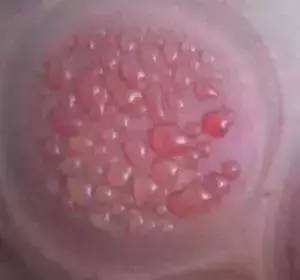
Individual Constitution Matters in Cupping
In TCM, excessive dampness is a common ailment among modern people. The same “heavy dampness” can be categorized into external dampness and internal dampness based on the site of onset and symptom presentation.
External dampness is caused by humid summer weather, or living in damp conditions, exposure to rain, wearing wet clothes, or bathing and then being exposed to air conditioning, leading to external evils invading the body, preventing the evaporation of body fluids, resulting in stagnant dampness. Common symptoms include wind-damp joint pain, lower back pain, etc. Internal dampness is often related to digestive function. TCM believes that the spleen has the function of “transporting and transforming water and dampness”; if the body is weak, has poor digestion, overeats, stays up late, or frequently consumes greasy, sweet, spicy, or barbecued foods, the spleen cannot function normally, leading to “internal dampness retention,” presenting symptoms such as thick and greasy tongue coating, tastelessness, thirst with burning sensation, poor appetite, abdominal bloating, loose stools, and sores.
Cupping therapy is particularly effective for those with external dampness, while those with internal dampness are more suited for herbal regulation. This explains why some people find cupping effective while others do not. If one feels unwell and needs cupping, it is best to distinguish whether the constitution is of external or internal dampness.
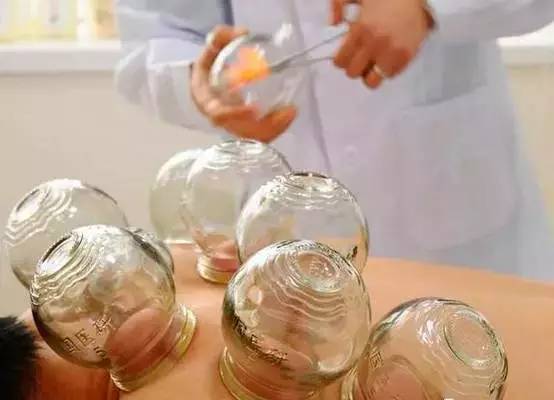
Cautions for Cupping Therapy
01. Individuals with Skin Allergies or Skin Injuries
Cupping may exacerbate allergic symptoms. Cupping should not be performed on ulcerated skin, as it may lead to infection and worsen the ulcer. If there are any skin lesions, cupping should not be performed on those areas. After cupping, one should not rush to take a shower to avoid skin damage and inflammation. Generally, once a week is a suitable frequency for cupping. During cupping, attention should be paid to the “heat level” and not to exceed the time limit. If blisters or burns occur, one should seek medical attention promptly.
02. Pregnant Women and Women During Menstruation
Especially on the abdomen and lower back, cupping is not advisable for pregnant women. Inappropriate cupping during pregnancy can lead to miscarriage. The same applies during menstruation; cupping on the lower abdomen or lower back can lead to excessive menstrual flow.
03. Individuals with Weak Constitutions
Cupping and scraping can be effective for cooling down, but some individuals should avoid such treatments. Those with heart disease, blood disorders, skin diseases, skin injuries, tuberculosis, osteoporosis, late-stage cancer, various infectious diseases, weak constitutions, and the elderly should use caution. Moreover, during cupping and scraping, one should avoid direct exposure to air conditioning or fans to prevent wind evil invasion.
04. After Eating Well
Blood flows to the liver for metabolic work; cupping at this time forces qi and blood to be redirected to the cupping area, causing the heart to pump faster, which may lead to dizziness, nausea, and other discomforts.
05. Repeated Cupping on the Same Area
Many patients often cup the same area repeatedly after becoming ill, which can damage the skin, causing redness, swelling, and lesions. It is advisable to cup in multiple areas to enhance treatment effects. Additionally, do not cup the same area until the previous cupping marks have disappeared.
06. Showering Immediately After Cupping
Many people like to take a shower right after cupping, thinking it feels comfortable; however, this is incorrect. Showering immediately can easily cause skin rupture and inflammation, especially with cold showers, as the skin’s pores are open, making one susceptible to colds. The correct time to shower is 1 to 2 hours after cupping. After cupping, keep warm, and the shower water should be slightly warmer.
Special Note: The various prescriptions and formulas mentioned in this article are for reference and learning by professional TCM practitioners only and should not be used as prescriptions. Please do not use them blindly; this platform does not bear any responsibility for any consequences arising from this.
Warm Reminder: Use your mind wisely; take medicine when ill, eat when healthy, and exercise appropriately.

